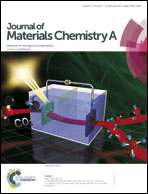Hybrid porous polymers constructed from octavinylsilsesquioxane and benzene via Friedel–Crafts reaction: tunable porosity, gas sorption, and postfunctionalization†
Abstract
Friedel–Crafts reaction of cubic octavinylsilsesquioxane (OVS) and benzene results in a series of hybrid porous polymers (HPPs). The resulting materials, HPP-1 to HPP-4, show relatively high porosity with apparent Brunauer–Emmett–Teller surface areas in a range of 400 m2 g−1 to 904 m2 g−1, with total pore volumes in the range of 0.24 cm3 g−1 to 0.99 cm3 g−1. Their porosities can be fine tuned by adjusting the mole ratios of OVS and benzene. They feature both micro- and mesopores (HPP-1 and HPP-2) to almost mesopores (HPP-3 and HPP-4) in the networks. The ratios of micropore volume to total pore volume for HPP-1 to HPP-4 were 0.58, 0.42, 0.10, and 0.11, respectively. These materials exhibit comparable surface area and high thermal stability in a N2 atmosphere. The gas sorption applications reveal that HPP-3 possesses a H2 uptake of 3.47 mmol g−1 (0.70 wt%) at 77 K and 760 mmHg and a CO2 uptake of 0.62 mmol g−1 (2.73 wt%) at 298 K and 760 mmHg. These results indicate these materials are promising candidates for storing H2 and CO2. In addition, HPP-4 has been successfully postfunctionalized with 3-mercaptopropionic acid via thiol–ene “click” reaction.


 Please wait while we load your content...
Please wait while we load your content...